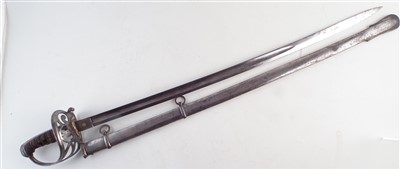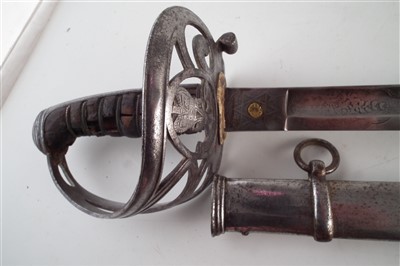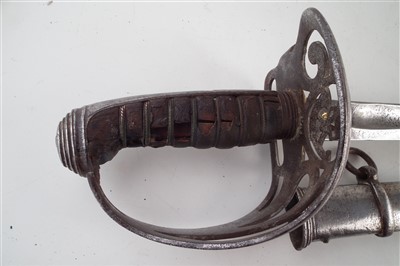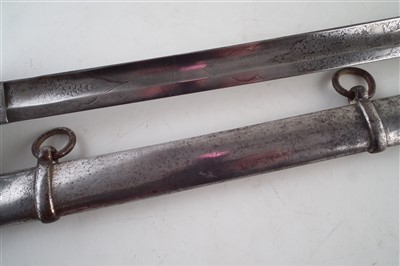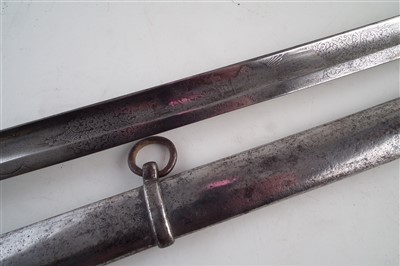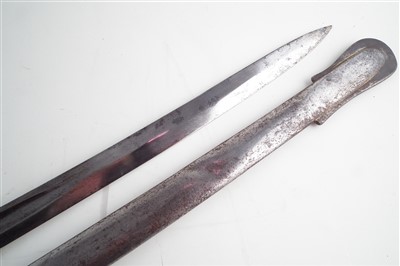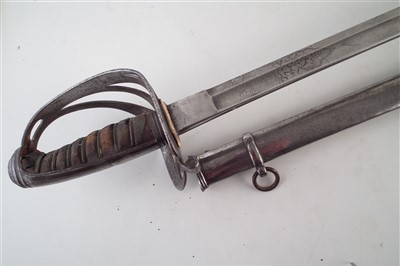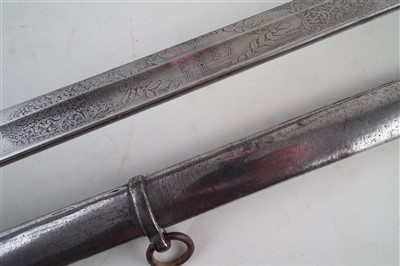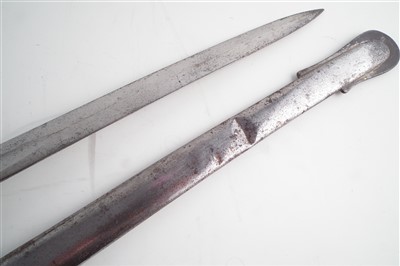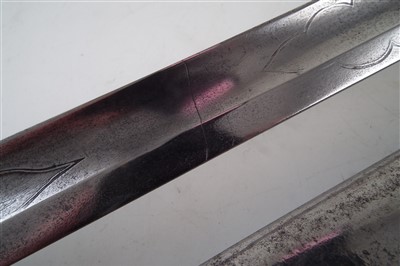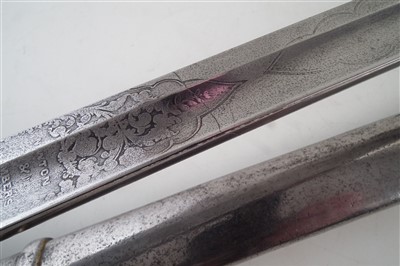26th Sep, 2019 10:00
Arms, Militaria, Shotguns, Firearms and Airguns
166
Kings Own Staffordshire Rifles 1822 pattern sword and scabbard.
Kings Own Staffordshire Rifles 1822 pattern sword and scabbard, retailed by Newton & Chambers London, with VR monogram to blade, reputed to be ex Donnington Hall, 100cm overall length.
When the current owner acquired this sword he was informed that it had originally been purchased from a 1985 sale at Doddington Hall, near Nantwich. The auction was for the clearance of Goudhurst Ladies College which occupied Donnington Hall from 1946 until its closure in 1985.
Donnington Hall had been the long time home of the Delves Broughton family. During the second world war the Hall and its ground had become home to the Free French forces and then the American forces. Following the war, the Nissan Huts became the home to displaced persons. Following this the Hall had been turned into an exclusive girls school.
Sir Delves Louis Broughton (b-1857-d1914) Became a Lieutenant in the 4th Battalion Prince of Wales (North Staffordshire) Regiment. The linage of the The King's Own (3rd Staffordshire) shows that they were formed at Lichfield on 5th April 1853 as the 73rd or the Kings Own (3rd Staffordshire) Militia and by June of the same year, the title had changed to the 73rd or the Kings Own (3rd Staffordshire) Rifles. On 1 July 1881 they became, following the Childers Reforms, the 4th Battalion The Prince of Wales (North Staffordshire) Regiment.
It would appear that Lieutenant Delves Louis Broughton, (he did not succeeded to the title until 26 February 1899) first joined the King's Own Staffordshire Rifles and was promoted to Lieutenant around 1881.
The following article was written by the vendor regarding this sword.
The Delves Broughton Sword and the unusually award of a British War Medal for a temporary visit.
A recent visit to a Cheshire auction room, led to the acquisition of a rather interesting sword.
Listed as a Staffordshire Light Infantry sword in the catalogue. On closer inspection a rather distressed sword and scabbard. The makers mark showing that it had been manufactured in London by Newton and Chambers.
Most excitingly the name of the Regiment 'King's Own Stafford Rifles'.
I recalled the excitement of a friend of mine, when he had fond a button marked with SR and a Stafford Knot. Perhaps it was worth enquiring more of the auctioneer. Robert Stone told me that the vendor had
purchased the sword from the sale of Doddington Hall, near Nantwich, Cheshire. When the auction of the chattels of the then Girls School, Goudhurst, had taken place in 1985.
The Hall, the long time home of the Delves Broughton family, until the Second World War, when the grounds became home to the Free French Navy and followed by American troops. Following the war , the large hutted camp had then become refuge to the displaced Poles. Following the war, the School had been established.
Readers of a more senior year may recall the scandal of 'Jock' Delves Broughton. Or the book and film based on the latter part of his life: 'White Mischief'.
My interest now aroused in the Delves Broughton family lead me to investigate further and what a story that sword has started to tell. The original owner of the sword, I believe was Sir Delves Louis Broughton, 10th Baronet. 1 June 1857 - 15 April 1914.
Who became a Lieutenant in the service of the 4th Battalion, Prince of Wales (North Staffordshire) Regiment. The lineage of The King's Own (3rd Staffordshire) Militia, shows that they were formed at Lichfield on 5 April 1853, as the 73rd or The King's Own (3rd Staffordshire) Militia and by June of the same year, the title had changed to 73rd or The King's Own (3rd Staffordshire) Rifles.
By 1 July 1881, following the Childers Reform (Secretary of State - Hugh Childers) they had become the 4th Battalion, The Prince of Wales (North Staffordshire) Regiment. The title would again change 1 January, 1921 when the became the 4th Battalion, The North Staffordshire (Prince of Wale's).
It would appear that Second Lieutenant Delves Louis Broughton, (he did not succeeded to the title until 26 February 1899) first joined The King's Own Staffordshire Rifles and gained his Lieutenancy after 1881, when they had become the 4th Battalion.
The Sword therefore must have been manufactured between 1853 and 1881. A pattern 1827 Infantry Officer's Sword, probably dating from around 1875, when Broughton, would have been celebrating his eighteenth birthday and old enough to have obtained his commission.
Sadly, the years of neglect have taken their toll. The wooden hilt has split. The guard, badly pitted, the Light Infantry symbol, pitted.
The scabbard has obviously stood in a damp corner, as the bottom three inches were badly rusted when I purchased it,
Henry John Delves Broughton, son of Delves Louis Broughton and his wife, Rosamund (1861 - 1885) was born 10 September 1883 and was the only surviving ing child of this marriage. Which apparently lead to a rather loveless childhood, leaving him with a sense of deprivation. He was educated at Eton, where his Father's meanness apparently led him to theft. Following his entrance to the Royal Military College, Sandhurst in 1900, he was commissioned into the Irish Guards 1902.
He became aide de camp to the Lieutenant Governor of the United Provinces of Agra and Oudh in 1908.
By 1911 he had been promoted to Captain. He married at the Guard's Chapel, Wellington Barracksto Vera Edyth Griffith-Boscawen on 8 July 1913.
On 15 April 1914 his Father died and he succeeded to the title and became the 11th Baronet and along with the title inherited 15,200 acres of land, plus the Halls of Doddington and Broughton.
With the outbreak of the war, general mobilisation was ordered and over 1300 reservists of the Irish Guards were called up. Reporting for city the next day. On 11 A7gust the 1st Battalionaere inspected by the Colonel of the Regiment, Field Marshall Lord Roberts. The following day, the embarked at Southampton on the P and O ship, S S Novara. Following a hard, hot day's labouring, getting all their equipment on board, the men were extremely tired. Unfortunately, Major Sir Delves Broughton was taken ill, with sun stroke. His replacement, Captain H. Hamilton Berners was rapidly called up and sailed with the Batfalion, in command of No 3 Company, being killed on 14 September 1914.
This brief mention was made by Rudyard Kipling, whose son, John, served and lost his life with the Regiment. At first the only other mention that U was able to find regarding his service, was that he was 'noted for his outstanding skill at cards'.
The National Biography tells he was promoted 'Major 15 July 1915, despite evading military action in the European war on the pretext of sunstroke' 'Retiring from the Army, April 15 1919 he was excluded from the List of Etonians who fought in the Great War. A check of his Medal index card has him on the General List and then the Irish Guards, showing his entitlement of the 'War Medal' and eligible for the Silver War Badge. 'Having first served in France'. The date of entry into France is shown as 'Temporary Visit'.
It is of interest to note that in1915, he became a Justice of the Peace in Cheshire.
Following the war in the early 20's Jock and his wife would be found in Africa, big game hunting. So much for sun stroke!
The true character of the man is now seen to emerge. A Silver War Badge for Sun Stroke!
His inheritance was swiftly being eroded away. He was losing his fortune not only on the race courses and card tables, but on speculative purchases in foreign exchange markets commodity dealing and mining shares. A short lived term as chairman of Dalkeith (Ceylon) Rubber Estatesand Director of Pindenioya Rubberand Tea Estates, also Coffee plantations in Kenya. Many of the ventures were funded, by the illegal selling of much of his estate, which in fact, was not his to sell, it being in Trust. In 1939 his own son took legal Ctionagainst him, to stop the trust being destroyed, Thft of valuable Pearl's from a car in the French Rivierain the summer of 1939. Which was followed by three heavily insured poetraitsfrom Doddington Hall,led to Inaurance and Police investigations. Un 1940 the estate assets were so water that he closed doddington and moved to Kenya. His wife had a number of affairs, leaving him in 1935, for Baron Moyne,Walter Gunnness and began divorce proceedings in 1939. From around 1935 he had pursued Diana Caldwell (1913 - 1987), whom he married in Durban, 5 November 1940. An unfortunate marriage!
Within three months, it had led to murder.
Following their marriage, they set up home in 'Happy Valley' Kenya and began to frequent the Muthaiga Country Club. Here they met, Josslyn Victor Hay, 2nd Earl of Erroll, the hereditary High Constable of Scotland on 30 November. Unfortunately he was 'a sensualist with no sense of irony, whose conquests were an exercise of power over women and of
humiliating dominance over their men folk. 'To hell with husbands' was one of his favourite sayings'.
Erroll is described as 'wonderfully good looking, with golden hair and blue eyes, with which he could cast a scornful look'. 'Mentally undisciplined and physically restless Erroll's set pursued a radish lied of adulteries, binge drinking, cocaine, card sharing, bilked tradesmen, spasmodic violence and insanity'. His first wife divorced him, as he was cheating her - financially!
Within days of them meeting, she had become another conquest and at first her older husband was quite prepared to play the complainant husband. But a series of anonymous letters goaded him into action. 21st January 1941 saw both men consulting their solicitors. Three nights later, they were at the Country Club together, where Jock Broughton left his wife in the company of the Earl. Having returned her home, the Earl was later ambushed in his Buick, as he returned home. He was discovered, shot through the headmaster slumped in his car.
Two bullets were recovered, one from the body, another in the footwell near the accelerator pedal. The weapon was never found. Delves Broughton was charged with murder on 10 March 1941. The trial began 26 May. Both his revolvers, Colts had been reported stolen, a few days before the shooting occurred. The bore of the recovered bullets was of .32 calibre, the trifling being clockwise with five grooves. The rifling on all Colts was anti clock-wise and had six rifling grooves.
There were no witnesses to the murder and the prosecution had a very weak case. A good lawyer, at the cost of some £5000,saw the Jury clear Delves Broughton on 1st July.
He soon became an outcast in Happy Valley and returned to England, November 1942. Where he found the Police were continuing their investigations into the theft of the paintings and Pearl's.
A broken man he died in an ambulance, speeding him from the Adelphi Hotel, to Liverpool's Northern Hospital, on 5th December, having injected himself fourteen times with a morphine derivative.
He was interred at the family Church, Broughton Hall near Eccleshall on 10th December.
In 1982, J Fox published 'White Mischief' and in 1987 the film of the same name was released in 19i7.
So, with a little detective work, a rather sorry sword has revealed a rather interesting history.
POSTAGE AND SHIPPING INFORMATION
This is a 'live online' auction - you can bid from the comfort of your own home using our free live bidding service.
Sold for £130
Auction: Arms, Militaria, Shotguns, Firearms and Airguns, 26th Sep, 2019
Live bidding available through our website.
Viewing
Saturday 21st 9.30am-12pm
Wednesday 25th 9am-5pm
Morning of auction 9am-10am
Alternative viewing times by appointment.
Sell a similar item
Please complete the form below. To help us with your valuation, please attach at least 1 clear photograph of your item.

